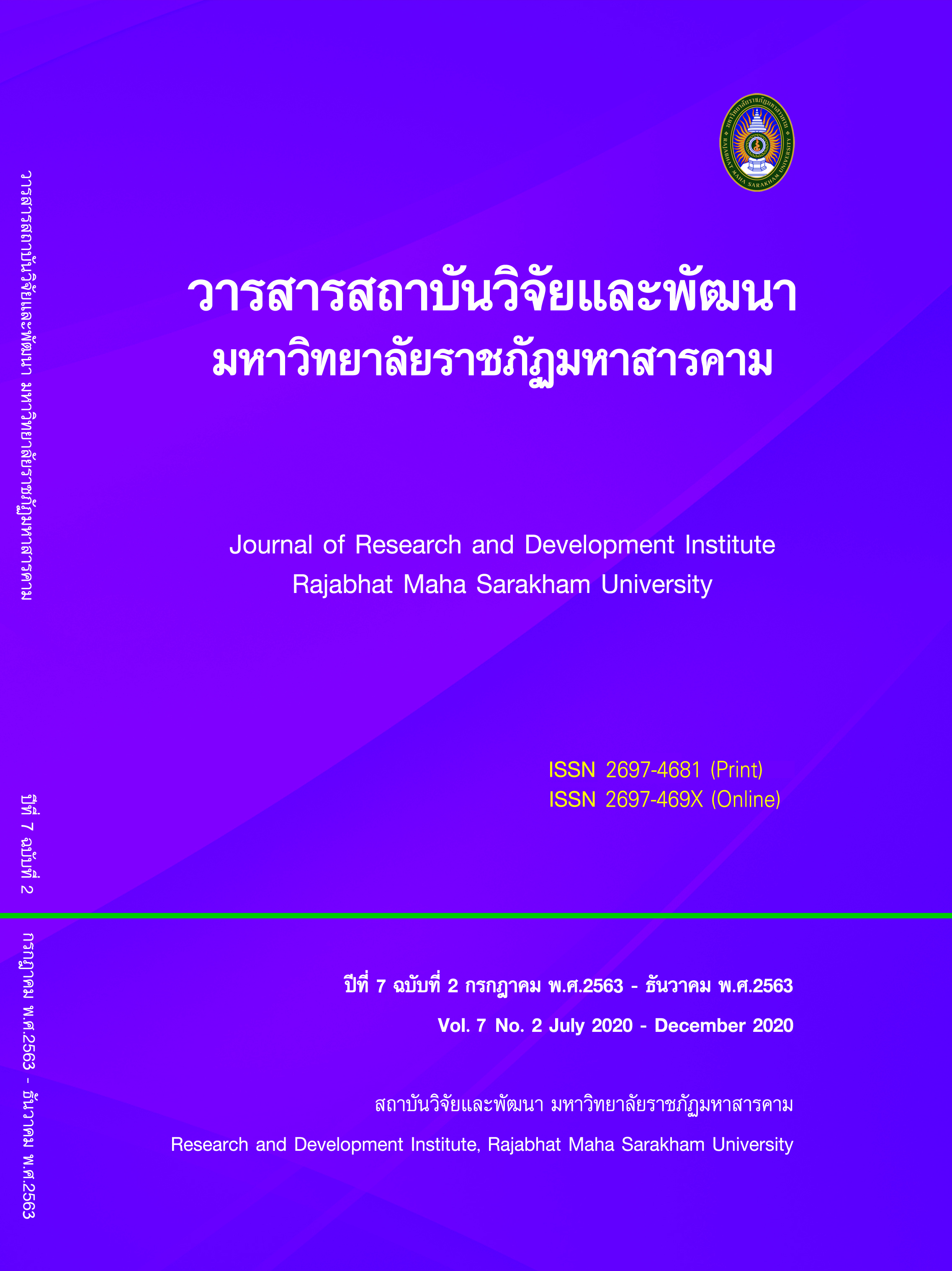The Administrative Model for STEM Education Schools
Keywords:
Administrative model, STEM EducationAbstract
The purposes of this research were to: analyze the factors of the administration of STEM Education schools, develop the administrative model, evaluate the administrative model of STEM Education schools. The steps of research process were as follows: step 1 was the factor analysis of the administration of STEM Education schools based on document studying, interviewing 9 experts, and data collecting which was taken from a sample group of 400 participants. The research instruments used were a document analyzing form, an interviewing form, and a questionnaire with the reliability coefficient of 0.98. The statistics used were frequency, percentage, mean, standard deviation, and Exploratory Factor Analysis: EFA, step 2 was the development of the administrative model of STEM Education schools by holding a connoisseurship from 9 experts. The instruments employed were a drafting of the administrative model of STEM Education schools, and documents for holding the connoisseurship. The statistics employed was content analysis, and step 3 was the evaluation of the administrative model of STEM Education schools. The data was collected from 9 administrators of STEM Education schools. The research instrument employed was a model evaluation form. The statistics used were mean and standard deviation.
The research findings were as follows: The results of the factor analysis for STEM Education schools comprised 6 factors and 57 variables were 1) instruction 14 variables , 2) strategic planning 12 variables, 3) work evaluation and assessment 11 variables, 4) learner’s quality defining 10 variables, 5) work development 6 variables, and 6) resource management 4 variables. The results of the development of the administrative model of STEM Education schools consisted of 3 parts were part 1: introduction was the basic concept and the purposes of the model, part 2: content included the factors of STEM Education schools and the administrative process of STEM Education schools, and part 3: successful condition. The results of the model evaluation from expert’s confirmation shown that the model included the accuracy, the propriety, the feasibility and the utility. The results of the valuating for the administrative model of STEM Education schools found that the accuracy, the propriety, the feasibility and the utility were at the highest level.
References
References
Ampai Nongyao, Chonchakorn Worain, and Anucha Kanpong. (2017). Model of School Administration for Developing Students’ Learning Skill in the 21st Century. Journal of Community Development Research (Humanities and Social Sciences), 10 (1), 132-143.
Chamras Intalapaporn, Marut Patphol, Wichai Wongyai, and Srisamorn Pumsa-ard. (2015). “The study guidelines for learning management of the STEM Education for elementary students” Veridian E-Journal, Silpakorn University, 8 (1): 62-74.
Comin,M.C. (2004). Continuous improvement in New York state school district: A case study. Development, and Retention of Teachers. [Online], http: //www.nber.org/papers/w17177. [20 April 2017].
Eisner, E. (1976). “Education connoisseurship and criticism: Their form and functions in. Educational evaluation,” Journal of Aesthetic Education. 192-193.
Hair, J., et al. (2010). Multivariate data analysis. 7th edition. Upper saddle River, New Jersey: Pearson Education International
Krejcie, R. V. & Morgan, D. W. (1970). “Determining Sample Size for Research Activities”. Educational and Psychological Measurement, 30(3): 607-610.
Nittaya Phuphabang. (2016). THE USE OF A STEM ACTIVITY ON BIOPLASTICS FROM CASSAVA TO DEVELOP INTEGRATED SCIENCE PROCESS SKILLS FOR MATHAYOMSUKSA 2 STUDENTS. Master of Science Thesis (Chemistry Education): Burapha University.
Niwat Nakawech. (2011) Development of a Model for Lab School Administration. EAU Heritage Journal Social Science and Humanities, 1 (2), 77-87.
Nongluk Ruenthong. (2007). The Model of School Administration Effectiveness. Doctor of Philosophy (Educational Administration): Silpakorn University.
Nutnapha Ratniyom (2015). A STUDY OF CONDITIONS, PROBLEMS AND READINESSES OF STEM INSTRUCTIONAL MANAGEMENT AT THE ELEMENTARY SCHOOL LEVEL IN BANGKOK METROPOLITAN. Bangkok: Chulalongkorn University.
Paravee Sukrojana, Samran Meejang, Vithaya Jansila, and Sombat Nopparat (2013). “The Model of Change Management for Private Schools to Excellence” JOURNAL OF EDUCATION NARESUAN UNIVERSITY, 15 (4): 76-84.
Preeyaporn Wonganutrohd. (2001). Psychology of Personnel Management. Bangkok: fine print
Quang, L. T., Hoang, L. H., Chaun, V. D., Nam, N. H., Anh, N. T., & Nhung, V. T. (2015). Integrated Science, Technology, Engineering and Mathematics (STEM) education through active experience of designing technical toys in vietnamese schools. doi: 10.9734/BJESBS/2015/19429.
Rawan Thilanan. (2015). EFFECT OF LEARNING STEM EDUCATION PROJECT APPROACH ON THE ACHIEVEMENT AND THE SCIENTIFIC CREATIVE THINKING SKILL OF MATHAYOMSUKSA 6 STUDENTS. Master of Science Thesis (Science Education Graduate School: Nakhon Sawan Rajabhat University.
Rekha Srivichai. (2012). AN ADMINISTRATIVE MODEL FOR AN EFFECTIVE EARLY CHILDHOOD PRIVATE SCHOOL IN NONTHABURI PROVINCE. Doctor of Education Thesis (Educational Administration): Sripatum University.
Somsri Nanjatee and Watcharee Chuchart. (2017). “A Model of the 21st Century Desired Characteristics For student Quality Development” SWU educational administration journal. 14 (27): 10-19.
Suriya Howhan, Thatchai Chittranan, and Weerapon Sarabun (2016). “The Administration Model Towards Excellence of School Under the secondary Education Service Area office” Education Journal Mahasarakham University, 10 (4): 133-164.
Downloads
Published
How to Cite
Issue
Section
License
Articles that are published are copyrighted by the authors of the articles







